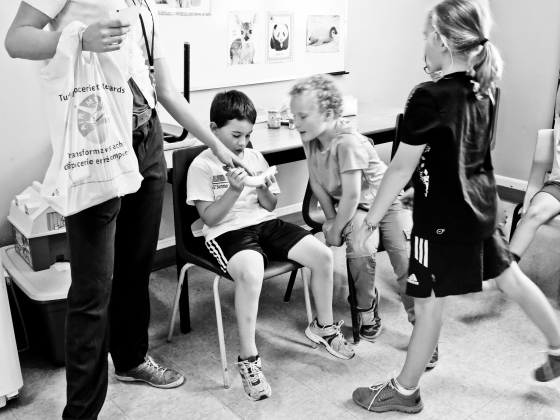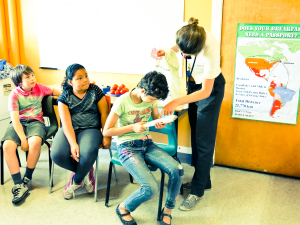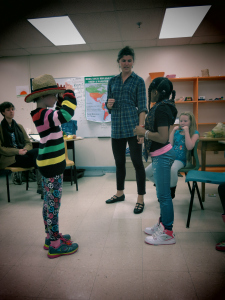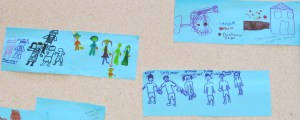Where does our food come from? And why? And how does it get here?…These can be complex questions to answer, and yet these were all questions groups of grades 4s were attempting to answer this week as part of the Good Food First Club.
The Good Food First Club is a program developed at the EAC, for upper elementary school students, and that is being piloted at 4 elementary schools in Halifax. The aim of the program is get kids out in the school garden, harvesting fruits and veggies and using this food to prepare healthy eats in the kitchen. More broadly we hope to get kids thinking critically about what food they are putting into their bodies and where it is coming from.
Where does our food come from?
“From the store!” Duhh. This the response of many kids. They’re right. And without really looking into this question, it’s easy not think about, where our food began it’s journey and how it got to us. But today, it’s all about diggin a lil’ deeper, and we start with a bag of groceries.
Kids reach into a grocery bag and pick out food items. Scan then label for the “product of_____” , and find that place on the map.
“See if we can find something from Nova Scotia” I say.
-Cheese…Mississauga
-Tomato…Mexico
-Banana….Guatemala
-Flour….Saskatchewan
-Milk….Nova Scotia! A-Ha! Found one.
-Apple….at this one many kids yell out, “from the valley!”
A lot have been apple picking before and know that we grow a lot of apples here. But alas, even though it’s apple season, this apple is from Chile. We find where Chile is on the map. It’s far. Actually, it’s just about as far away as you can get on our map of the Americas.
When asked why half of all the apples in Nova Scotia grocery stores come from outside of the province, kids struggle to find reasons. Many suggest, “because our apples are no good”. I tell them, that our apples ARE good, in fact we send our apples to other parts of the country.
Apples in, apple out. They looked stumped. And I don’t blame them.
One bright eyed boys pipes up “Trade economics!”. Whoa. That’s a mouthful. Another girl replies, “We don’t know what that means!”
“Well it’s cheaper to get those apples”, continues the boy. And this is the perfect segue to our next topic.
How does our food get here?
Tommy the Tomato has traveled very far to get to us today. He was actually grown in Mexico by a hard working farmer. How did he get all the way here? Kids work through the chain of events, thinking up different steps, and who has been involved. We have a farmer, who sells their tomatoes to the tomato company, who then hires a plane to fly to Canada, who then gets a truck to drive to Nova Scotia, who sells the tomatoes to the grocery store, who, then, sells the tomatoes to us! By the end of the charade we have a line of 5 or 6 kids with funny accesories standing of the middle room.
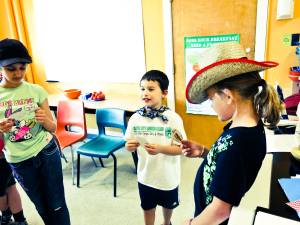
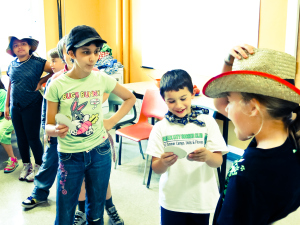

Say the tomato costs a dollar, how much of that dollar gets back to the farmer? We work through this by passing the buck (literally) down the line, with each person, skimming off a bit. Turns out our farmer is left with 5 cents.
“I feel ripped off!” exclaims our farmer.
What’s an alternative to this? How could we shorten this chain? I ask.
We try out another scenario, where our tomato is from Nova Scotia. This time, our farmer sells their tomatoes at the farmers market. Farmer drives to the market and sells to consumer. And gets to keep most of the dollar (they did have to stop a the gas station on the way points out one student). Our farmer seems a lot happier with this situation.
What are some other ways that our food could get to us?
Kids draw pictures of what they’ve learned, or of other ways food could get to us.
Some draw pictures of the food systems we’d talked about. Others of growing tomatoes in your backyard.
Others were still put off by the Mexican farmer measly payment, And wasted no time to try and solve this problem.
Why doesn’t the Mexican farmer fly their own food to Nova Scotia? They could become a pilot!
They’d be up all night I think to myself.
Yes! They continued. The farmers already have the fields; they just need to build a landing strip in the middle! Then they wouldn’t need a tractor- attach the hoe to the back of the plane! And there would be no middle man!
Its these kind of genuine, unbridled, un-jaded, ideas that makes me love working with kids.
If you’re interested in learning more on how to engage kids in talking about food, feel free to send me an email, Georgia@ecologyaction.ca

